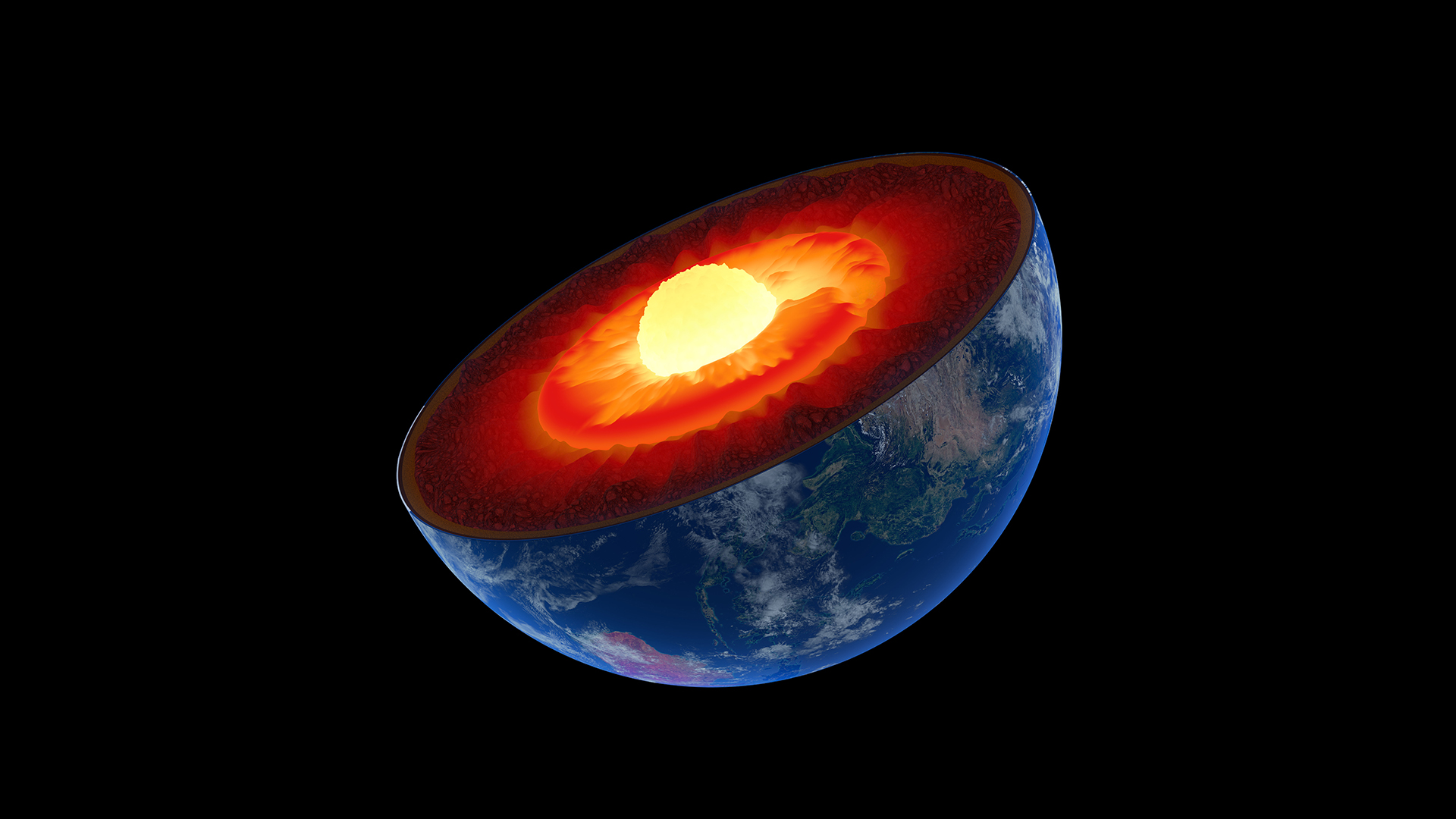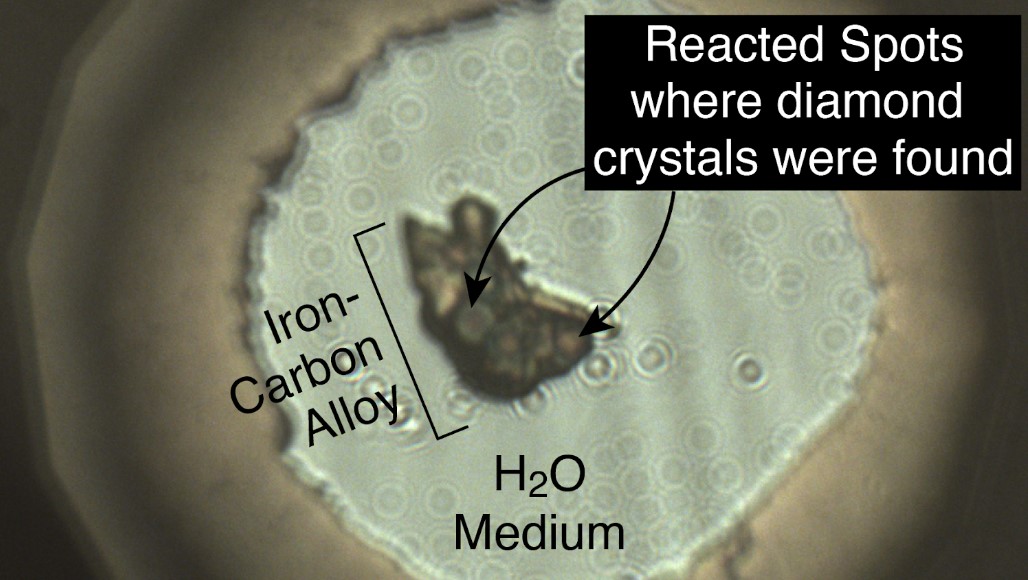Giant blobs in Earth’s mantle may be driving a 'diamond factory' near our planet’s core
Extreme chemical reactions could explain why Earth's middle layer has so much carbon.

The boundary zone between Earth's molten metal core and the mantle, its rocky middle layer, might be a diamond factory.
A new laboratory experiment finds that, under extreme temperatures and pressures, the combination of iron, carbon and water — all potential ingredients found at the core-mantle boundary — can form diamond. If this process also happens deep inside Earth, it might explain some weird quirks of the mantle, including why it has more carbon in it than scientists expect.
The findings also might help to explain strange structures deep in the core-mantle boundary where waves from earthquakes slow down dramatically. These regions, known as "ultra low velocity zones" are associated with strange mantle structures, including two giant blobs under Africa and the Pacific Ocean; they can be just a few miles across or many hundred. No one knows exactly what they are. Some scientists think they date back 4.5 billion years and are made of materials from the very ancient Earth. But the new research suggests that some of these zones may owe their existence to plate tectonics, which likely started well after Earth's formation, perhaps 3 billion years ago.
"We are adding a new idea that these are not entirely old structures," study lead author Sang-Heon Shim, a geoscientist at Arizona State University, told Live Science.
Simulating the deep Earth
Where the core meets the mantle, liquid iron rubs up against solid rock. That's as dramatic a transition as the rock-to-air interface at Earth's surface, Shim told Live Science. At such a transition, especially at high pressures and temperatures, strange chemistry can happen.
What's more, studies that use the reflections of earthquake waves to image the mantle have shown that materials from the crust may penetrate to the core-mantle boundary, some 1,900 miles (3,000 kilometers) below Earth's surface. At subduction zones, tectonic plates push under one another, driving oceanic crust into the subsurface. The rocks in this oceanic crust have water locked in their minerals. As a result, Shim said, it's possible that water exists in the core-mantle boundary and can drive chemical reactions down there. (One theory about the pair of mantle blobs under Africa and the Pacific is that they are made up of distorted oceanic crust that's been pushed deep into the mantle, potentially carrying water with it.)
To test the idea, the researchers pulled together the ingredients available in the core-mantle boundary and pressed them together with anvils made of diamond, generating pressures of up to 140 gigapascals. (That's about 1.4 million times the pressure at sea level.) The researchers also heated the samples to 6,830 degrees Fahrenheit (3,776 degrees Celsius).
Get the world’s most fascinating discoveries delivered straight to your inbox.
"We monitored what kind of reaction was happening when we heated the sample," Shim said. "Then we detected diamond, and we detected an unexpected element exchange between rock and the liquid metal."
Churning out diamonds
Under the pressure and temperature of the core-mantle boundary, Shim said, water behaves very differently than it does on Earth's surface. The hydrogen molecules split from the oxygen molecules. Because of the high pressure, hydrogen gravitates toward iron, which is the metal that makes up most of the core. Thus, the oxygen from water stays in the mantle, while the hydrogen melds with the core.
When this happens, the hydrogen seems to push aside other light elements in the core, including, crucially, carbon. This carbon gets booted out of the core and into the mantle. At the high pressures present in the core-mantle boundary, carbon's most stable form is diamond.
"That's how diamond forms," Shim said.
These aren't the same diamonds that might sparkle in an engagement ring; most diamonds that make their way to the surface, and ultimately become someone's jewelry, form a few hundred kilometers deep, not a few thousand. But the core-mantle diamonds are likely buoyant and could get swept throughout the crust, distributing their carbon as they go.
The mantle has three to five times more carbon than researchers would expect based on the proportion of elements in stars and other planets. The diamonds found in this layer of Earth might explain the discrepancy, Shim said. He and his team calculated that if even 10% to 20% of the water in oceanic crust makes it to the core-mantle boundary, it could churn out enough diamonds to explain the levels of carbon in the crust.
If that's the case, many of the low-velocity zones in the mantle might be areas of water-driven melt, triggered by the churn of the oceanic plates deep into the planet.
Proving this process happens thousands of kilometers below the surface is the next challenge. There are a couple of ways to look for evidence, Shim said.
One is to search for structures within the core-mantle boundary that could be clusters of diamonds. Diamonds are dense and would transmit earthquake waves quickly, so researchers would need to find high-velocity zones alongside the already-discovered regions where waves travel slowly. Other researchers at Arizona State University are investigating this possibility, Shim said, but the work isn't yet published.
Another option is to study diamonds that may come from very deep in Earth's mantle. These diamonds can sometimes make it to the surface with tiny pockets, or inclusions, full of minerals that can form only under very high pressure.
Even the famed Hope Diamond may have formed very deep in the planet's mantle. When scientists claim to have discovered very deep diamonds, those assertions are often controversial, Shim said, in part because the inclusions are so tiny that there is barely any material to measure. But it might be worth looking for core-mantle boundary inclusions, he said.
"That would be some kind of a discovery, if someone could find evidence for that," he said.
The researchers reported their findings Aug. 11 in the journal Geophysical Research Letters.
Originally published on Live Science.

Stephanie Pappas is a contributing writer for Live Science, covering topics ranging from geoscience to archaeology to the human brain and behavior. She was previously a senior writer for Live Science but is now a freelancer based in Denver, Colorado, and regularly contributes to Scientific American and The Monitor, the monthly magazine of the American Psychological Association. Stephanie received a bachelor's degree in psychology from the University of South Carolina and a graduate certificate in science communication from the University of California, Santa Cruz.



